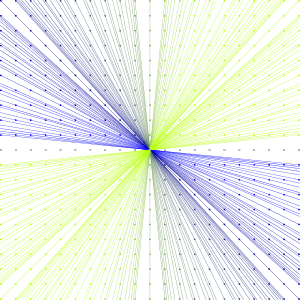Rational number
In mathematics, a rational number is a number that can be expressed as the quotient or fraction p/q of two integers, a numerator p and a non-zero denominator q.[1] Since q may be equal to 1, every integer is a rational number. The set of all rational numbers, often referred to as "the rationals", the field of rationals or the field of rational numbers is usually denoted by a boldface Q (or blackboard bold , Unicode ℚ);[2][3] it was thus denoted in 1895 by Giuseppe Peano after quoziente, Italian for "quotient".

The decimal expansion of a rational number always either terminates after a finite number of digits, or begins to repeat the same finite sequence of digits over and over.[4] Moreover, any repeating or terminating decimal represents a rational number. These statements hold true not just for base 10, but also for any other integer base (e.g. binary, hexadecimal).
A real number that is not rational is called irrational.[5] Irrational numbers include √2, π, e, and φ. The decimal expansion of an irrational number continues without repeating. Since the set of rational numbers is countable, and the set of real numbers is uncountable, almost all real numbers are irrational.[1]
Rational numbers can be formally defined as equivalence classes of pairs of integers (p, q) with q ≠ 0, using the equivalence relation defined as follows:
- (p1, q1) ~ (p2, q2) if and only if p1q2 = p2q1.
With this formal definition, the fraction p/q becomes the standard notation for the equivalence class of (p, q).
Rational numbers together with addition and multiplication form a field which contains the integers, and is contained in any field containing the integers. In other words, the field of rational numbers is a prime field, and a field has characteristic zero if and only if it contains the rational numbers as a subfield. Finite extensions of Q are called algebraic number fields, and the algebraic closure of Q is the field of algebraic numbers.[6]
In mathematical analysis, the rational numbers form a dense subset of the real numbers. The real numbers can be constructed from the rational numbers by completion, using Cauchy sequences, Dedekind cuts, or infinite decimals (for more, see Construction of the real numbers).
Terminology
The term rational in reference to the set Q refers to the fact that a rational number represents a ratio of two integers. In mathematics, "rational" is often used as a noun abbreviating "rational number". The adjective rational sometimes means that the coefficients are rational numbers. For example, a rational point is a point with rational coordinates (i.e., a point whose coordinates are rational numbers); a rational matrix is a matrix of rational numbers; a rational polynomial may be a polynomial with rational coefficients, although the term "polynomial over the rationals" is generally preferred, to avoid confusion between "rational expression" and "rational function" (a polynomial is a rational expression and defines a rational function, even if its coefficients are not rational numbers). However, a rational curve is not a curve defined over the rationals, but a curve which can be parameterized by rational functions.
Arithmetic
Irreducible fraction
Every rational number may be expressed in a unique way as an irreducible fraction a/b, where a and b are coprime integers and b > 0. This is often called the canonical form of the rational number.
Starting from a rational number a/b, its canonical form may be obtained by dividing a and b by their greatest common divisor, and, if b < 0, changing the sign of the resulting numerator and denominator.
Embedding of integers
Any integer n can be expressed as the rational number n/1, which is its canonical form as a rational number.
Equality
- if and only if
If both fractions are in canonical form, then:
- if and only if and
Ordering
If both denominators are positive (particularly if both fractions are in canonical form):
- if and only if
On the other hand, if either denominator is negative, then each fraction with a negative denominator must first be converted into an equivalent form with a positive denominator—by changing the signs of both its numerator and denominator.
Addition
Two fractions are added as follows:
If both fractions are in canonical form, the result is in canonical form if and only if b and d are coprime integers.
Subtraction
If both fractions are in canonical form, the result is in canonical form if and only if b and d are coprime integers.
Multiplication
The rule for multiplication is:
where the result may be a reducible fraction—even if both original fractions are in canonical form, .
Inverse
Every rational number a/b has an additive inverse, often called its opposite,
If a/b is in canonical form, the same is true for its opposite.
A nonzero rational number a/b has a multiplicative inverse, also called its reciprocal,
If a/b is in canonical form, then the canonical form of its reciprocal is either or , depending on the sign of a.
Division
If b, c, and d are nonzero, the division rule is
Thus, dividing a/b by c/d is equivalent to multiplying a/b by the reciprocal of c/d:
Exponentiation to integer power
If n is a non-negative integer, then
The result is in canonical form if the same is true for a/b. In particular,
If a ≠ 0, then
If a/b is in canonical form, the canonical form of the result is if either a > 0 or n is even. Otherwise, the canonical form of the result is
Continued fraction representation
A finite continued fraction is an expression such as
where an are integers. Every rational number a/b can be represented as a finite continued fraction, whose coefficients an can be determined by applying the Euclidean algorithm to (a,b).
Other representations
- common fraction:
- mixed numeral:
- repeating decimal using a vinculum:
- repeating decimal using parentheses:
- continued fraction using traditional typography:
- continued fraction in abbreviated notation: [2; 1, 2]
- egyptian fraction:
- prime power decomposition:
- quote notation: 3!6
are different ways to represent the same rational value.
Formal construction

The rational numbers may be built as equivalence classes of ordered pairs of integers.
More precisely, let (Z × (Z \ {0})) be the set of the pairs (m, n) of integers such n ≠ 0. An equivalence relation is defined on this set by
- (m1, n1) ~ (m2, n2) if and only if m1n2 = m2n1.
Addition and multiplication can be defined by the following rules:
This equivalence relation is a congruence relation, which means that it is compatible with the addition and multiplication defined above; the set of rational numbers Q is the defined as the quotient set by this equivalence relation, (Z × (Z \ {0})) / ~, equipped with the addition and the multiplication induced by the above operations. (This construction can be carried out with any integral domain and produces its field of fractions.)
The equivalence class of a pair (m, n) is denoted Two pairs (m1, n1) and (m2, n2) belong to the same equivalence class (that is are equivalent) if and only if this means that if and only
Every equivalence class may be represented by infinitely many pairs, since
Each equivalence class contains a unique canonical representative element. The canonical representative is the unique pair (m, n) in the equivalence class such that m and n are coprime, and n > 0. It is called the representation in lowest terms of the rational number.
The integers may be considered to be rational numbers identifying the integer n with the rational number
A total order may be defined on the rational numbers, that extends the natural order of the integers. One has if
Properties

The set Q of all rational numbers, together with the addition and multiplication operations shown above, forms a field.
Q has no field automorphism other than the identity.
With the order defined above, Q is an ordered field that has no subfield other than itself, and is the smallest ordered field, in the sense that every ordered field contains a unique subfield isomorphic to Q.
Q is a prime field, which is a field that has no subfield other than itself.[7] The rationals are the smallest field with characteristic zero. Every field of characteristic zero contains a unique subfield isomorphic to Q.
Q is the field of fractions of the integers Z.[8] The algebraic closure of Q, i.e. the field of roots of rational polynomials, is the field of algebraic numbers.
The set of all rational numbers is countable, while the set of all real numbers (as well as the set of irrational numbers) is uncountable. Being countable, the set of rational numbers is a null set, that is, almost all real numbers are irrational, in the sense of Lebesgue measure.
The rationals are a densely ordered set: between any two rationals, there sits another one, and, therefore, infinitely many other ones. For example, for any two fractions such that
(where are positive), we have
Any totally ordered set which is countable, dense (in the above sense), and has no least or greatest element is order isomorphic to the rational numbers.
Real numbers and topological properties
The rationals are a dense subset of the real numbers: every real number has rational numbers arbitrarily close to it. A related property is that rational numbers are the only numbers with finite expansions as regular continued fractions.
By virtue of their order, the rationals carry an order topology. The rational numbers, as a subspace of the real numbers, also carry a subspace topology. The rational numbers form a metric space by using the absolute difference metric d(x,y) = |x − y|, and this yields a third topology on Q. All three topologies coincide and turn the rationals into a topological field. The rational numbers are an important example of a space which is not locally compact. The rationals are characterized topologically as the unique countable metrizable space without isolated points. The space is also totally disconnected. The rational numbers do not form a complete metric space; the real numbers are the completion of Q under the metric d(x,y) = |x − y|, above.
p-adic numbers
In addition to the absolute value metric mentioned above, there are other metrics which turn Q into a topological field:
Let p be a prime number and for any non-zero integer a, let |a|p = p−n, where pn is the highest power of p dividing a.
In addition set |0|p = 0. For any rational number a/b, we set |a/b|p = |a|p / |b|p.
Then dp(x,y) = |x − y|p defines a metric on Q.
The metric space (Q,dp) is not complete, and its completion is the p-adic number field Qp. Ostrowski's theorem states that any non-trivial absolute value on the rational numbers Q is equivalent to either the usual real absolute value or a p-adic absolute value.
See also
References
- Rosen, Kenneth. Discrete Mathematics and its Applications (6th ed.). New York, NY: McGraw-Hill. pp. 105, 158–160. ISBN 978-0-07-288008-3.
- "Compendium of Mathematical Symbols". Math Vault. 2020-03-01. Retrieved 2020-08-11.
- Rouse, Margaret. "Mathematical Symbols". Retrieved 1 April 2015.
- "Rational number". Encyclopedia Britannica. Retrieved 2020-08-11.
- Weisstein, Eric W. "Rational Number". mathworld.wolfram.com. Retrieved 2020-08-11.
- Gilbert, Jimmie; Linda, Gilbert (2005). Elements of Modern Algebra (6th ed.). Belmont, CA: Thomson Brooks/Cole. pp. 243–244. ISBN 0-534-40264-X.
- Sūgakkai, Nihon (1993). Encyclopedic Dictionary of Mathematics, Volume 1. London, England: MIT Press. p. 578. ISBN 0-2625-9020-4.
- Bourbaki, N. (2003). Algebra II: Chapters 4 - 7. Springer Science & Business Media. p. A.VII.5.
External links
| Wikimedia Commons has media related to Rational numbers. |